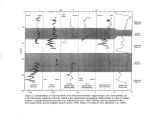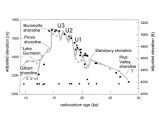| OCR Text |
Show September 17- 20, 1997 Salt Lake City, Utah CONFERENCE CHAIR Geography Program Coordinator Don Currey Department of Geography 21 ID OSH University of Utah Salt Lake City, UT 84112 Tel: 801- 581- 6419 Fax: 801- 581- 8219 Email < don. currey@ geog. utah. edu> Biological Program Coordinator Robert Hershler Department of Invertebrate Zoology NHB STOP 118 National Museum of Natural History Smithsonian Institution Washington, DC 20560 Tel: 202- 786- 2077 Fax: 202- 357- 2343 Email < mnhiv007@ sivm. si. edu> Planning Committee David Madsen Utah Geological Survey 1594 West North Temple Salt Lake City, UT 84114 Tel: 801- 537- 3314 Fax: 801- 537- 3400 Email < nrugs. dmadsen@ state. ut. us> Planning Committee Peter Hovingh 721 Second Avenue Salt Lake City UT 84103 Tel: 801- 359- 4791 Email < Peter. Hovingh % bbs @ wasatch. com> Registration Information Conferences 2174 Annex University of Utah Salt Lake City UT 84112 Teh 801- 581- 5809 Fax: 801- 581- 3165 Email < confer@ admin. dce. utah. edu> Dear Colleagues: We take pleasure in welcoming you to Salt Lake City, to the University Park Hotel, and to the GBASH 97 conference on Great Basin Aquatic System History. While you are here, we trust you will enjoy the warm hospitality, scenic beauty, and pleasant early Autumn weather ( all bets are off in major ENSO years) for which this region is noted. A meeting of the Pacific Division of the AAAS in Salt Lake City, Utah, on June 16,1942, ( 11 days after the Battle of Midway) included a symposium on the glacial and postglacial history of the Great Basin. Among the papers presented at that symposium were seminal contributions on Cenozoic geology by Eliot Blackwelder, on zoogeographical evidence by Carl L. Hubbs and Robert R. Miller, and on paleoclimates ( including the first use of the term Altithermal) by Ernst Antevs. Updated somewhat after World War II, those three papers were collected in a 191- page symposium volume that was published by the University of Utah on June 30,1948. Titled The Great Basin, with Emphasis on Glacial and Postglacial Times, that small but classic volume has for almost fifty years stood as a landmark in the literature of what Don Grayson refers to as the natural prehistory of the Great Basin. Two generations of Great Basin scientists have been inspired by the vision and challenged by the hypotheses of those who pointed the way half a century ago. As Hubbs and Miller stated in the original symposium, " Even greater advances should ensue, when the biological and geological approaches are more definitely integrated. We eagerly look forward to the time when we may join with the glacial geologist to journey, helping hand in helping hand, across the desert mountains and flats of the Great Basin, together attempting to unlock some of the doors that are yet closed to us." The goals of GBASH 97 are ( 1) to review the five decades of post- 1940s research progress that our several disciplines and proliferating specialities have made in probing and partially deciphering the Great Basin's world- class records of aquatic prehistory- not only as records of regional aquatic change, but also as regional windows on the dynamics of global climate change; ( 2) to note with a broadening sense of perspective where our respective research cutting edges are positioned currently; and ( 3) to anticipate more clearly where the most promising research frontiers and research collaboration opportunities may lie in the foreseeable future. Those who participated in the 1942 symposium are mostly gone, with only Robert Rush Miller remaining from among the 1948 authors. They have been superb role models and are now icons. Over the decades, their torch has been passed to other students of Great Basin natural prehistory. From the vantage point of the conference organizers, that torch ( or, less figuratively, the mass spectrometer and SEM) is shining brightly and is in dozens- and counting- of increasingly capable hands. For the conference organizers, oofa> i Don Currey Conference Chair |

































































































































































